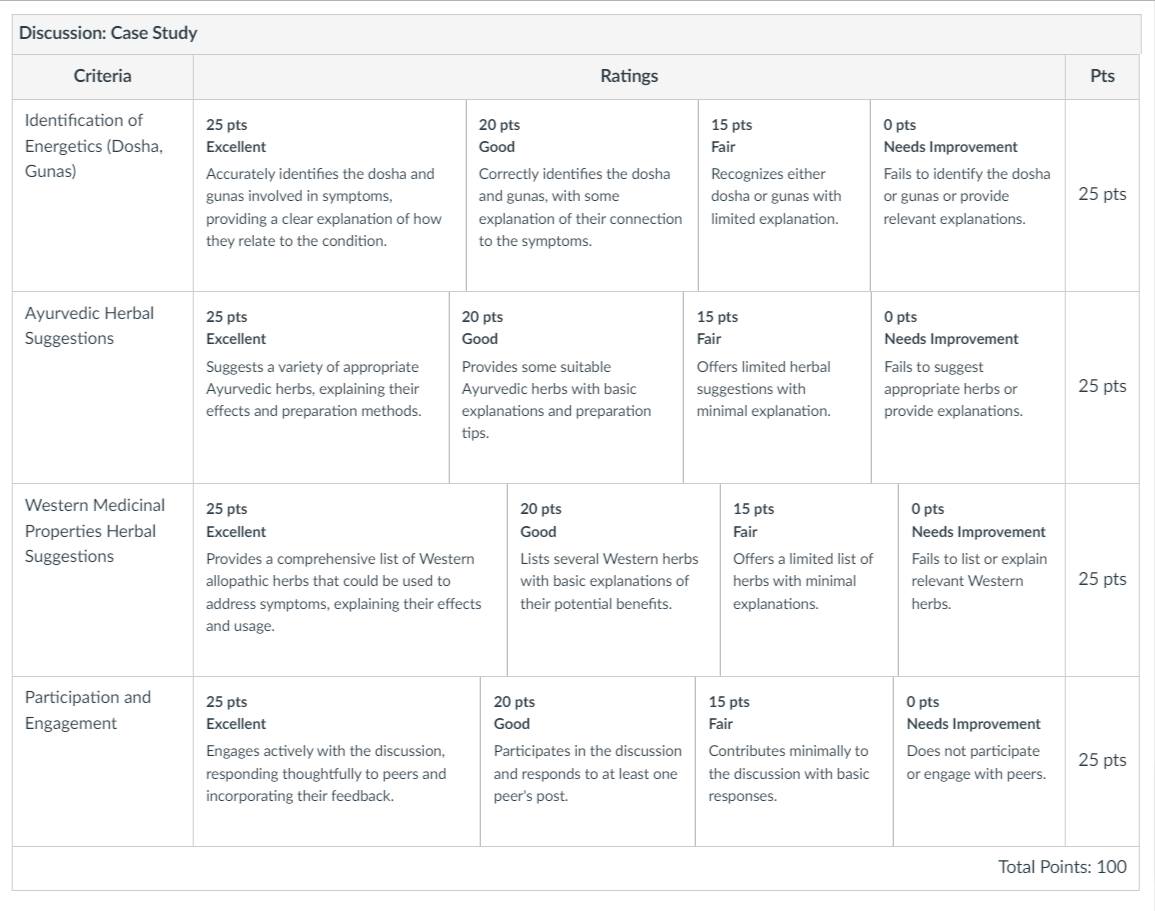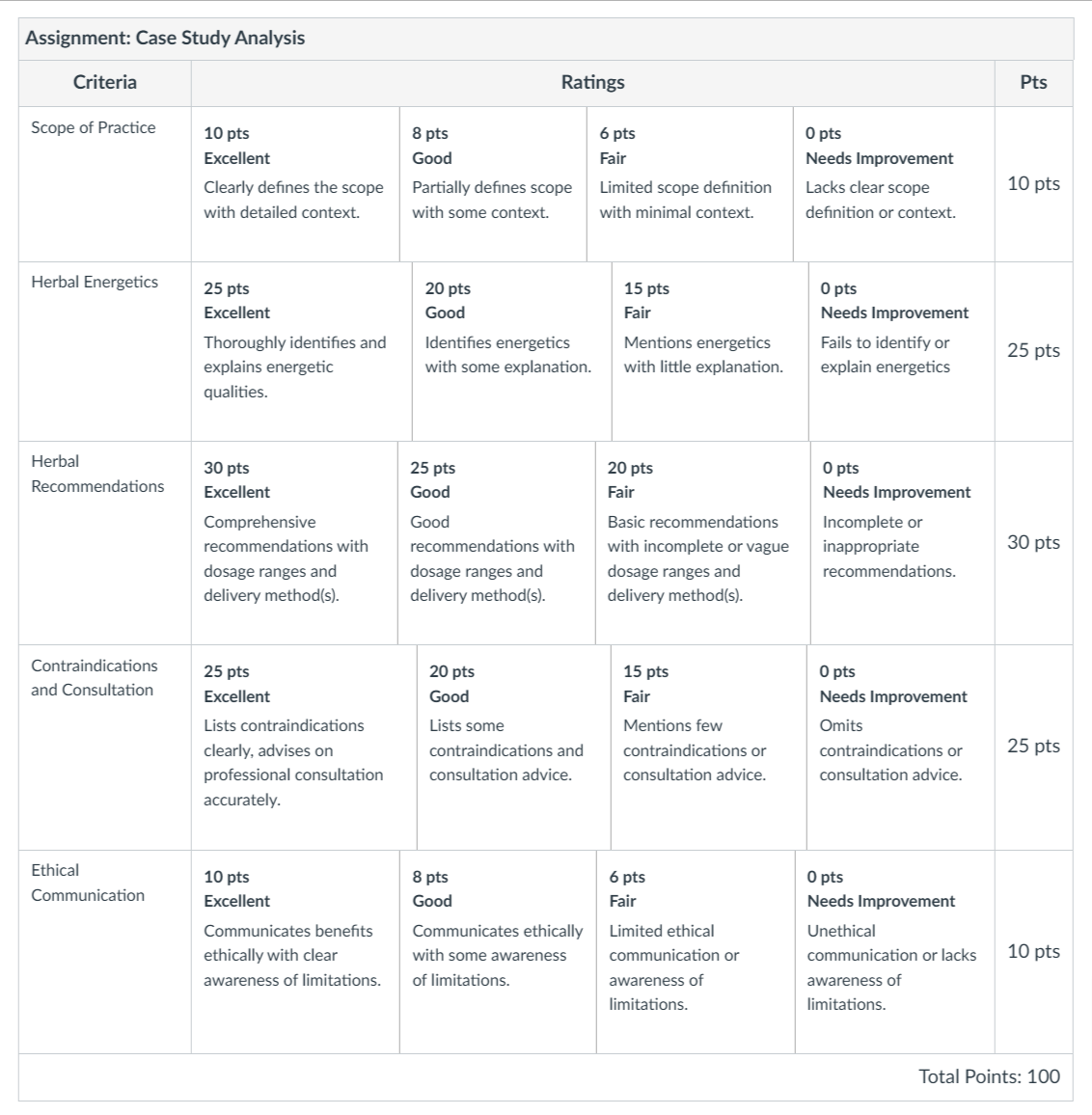LDT400x Week 5
Discussion & Assignment Prompt Rubrics

Having a clear set of rubrics to guide grading can be very helpful for students and teachers. Perhaps the biggest challenge is to create rubrics that are meaningful and offer a fair grading system. I have seen far too many rubrics in online classes that put too much weight on nitpicky things that have no bearing on what student actually need to know. An example of a poor rubric would be one that marks students off for something petty like not having a title page formatted exactly so. In creating my rubric, I tried to focus on what students actually need to know vs. how perfect their spelling or formatting is. I also had to play around with the point assignments. Canvas will automatically assign points in such a way that a second-level "Good" score could come out as a D numerically!

Review the materials in the Herbal Frameworks and Energetics module for information that will help you complete this discussion prompt.
Alex, a 35-year-old office worker, has recently been experiencing frequent heartburn and acid reflux. He describes a burning sensation in his chest and occasional nausea. Despite his hectic schedule, Alex often feels irritable and struggles to concentrate. He is seeking natural options to alleviate these symptoms and restore balance to his digestive system.
Instructions:
In this discussion, focus on Alex's symptoms from an Ayurvedic perspective. As beginning herbalists, your task is to explore herbal remedies that are traditionally used in Ayurveda to calm the digestive system. Discuss how these herbs might help alleviate Alex’s symptoms and promote overall digestive health. You should also then select some Western herbs using allopathic medicinal properties.
First, identity the energetics involved (dosha, gunas, etc.). Then, select appropriate Ayurvedic herbs. Explain your choices. Third, choose herbs based on Western medicinal properties. Explain your choices. You do not need to worry about dosage or type of herbal delivery yet, as we will get to that in the next module. Once you have posted, comment on at least two other posts.

Review the materials in the Herb Safety and Herbal Frameworks and Energetics modules for information that will help you complete this assignment.
While the scope of this course is not to teach you how to become a professional herbalist, practicing with case studies is a good way to build your knowledgebase, make you better equipped to help friends and family, and help prepare you to become an herbal professional in the future.
Instructions:
Choose one of the following three case studies. Your task is to analyze the case and provide herbal recommendations for treatment. Focus on selecting appropriate herbal remedies, considering dosage, type of delivery, and prioritizing safety by checking for any potential contraindications. Ensure your recommendations align with the scope of practice for an herbalist and communicate ethically and cautiously.
Case Studies:
Case Study 1: Seasonal Allergies
Profile: Alex, a 30-year-old male, experiences mild seasonal allergies characterized by sneezing, runny nose, and itchy eyes during the spring. He has a sturdy build, smooth skin, and often feels sluggish or lethargic.
Lifestyle: Alex plays video games professionally on Twitch. He tends to sit too much and eat junk food when stressed. He lifts weights at the gym for exercise.
Case Study 2: Pre-Menopause
Profile: Jamie, a 50-year-old female, is starting to develop hot flashes as she enters pre-menopause. She has a medium build, oily skin, and a tendency to feel warm. She enjoys spicy foods but often eats late at night due to her busy schedule.
Lifestyle: Jamie works in a stressful corporate environment and exercises moderately. She would prefer lifestyle changes and herbs over using HRT for menopause.
Case Study 3: Stress and Mild Anxiety
Profile: Taylor, a 25-year-old female, experiences stress and a feeling of anxiety due to work pressure. She says she feels like her mind is a "hamster wheel." She often feels cold, has dry skin, and a light build. Taylor is looking for ways to manage stress naturally.
Lifestyle: She works as a graphic designer with flexible hours but often stays up late working on projects. She practices yoga regularly and follows a vegetarian diet. Although she has a stable job, she often feels anxious about work deadlines.
Assignment Requirements:
Define the scope of practice for your recommendations.
Identify and explain herbal energetic qualities related to the chosen case study.
Provide a detailed recommendation of herbal remedies, including dosage and type of delivery.
List any potential contraindications and when to consult a health professional.
Ensure all communication is ethical and within personal knowledge limitations.
Submit your completed analysis by the due date in a clear, well-organized document or video report with transcript - linking to your video that is publicly accessible, such as on YouTube.
Note: To access direct links to discussions and assignments, you can sign up to the course for free here:
https://canvas.instructure.com/enroll/B8WJNW
Rubric for Discussion Prompt: Case Study: Heartburn
Click on the little 3 dots on the upper right--hand corner underneath "100 points possible" and select "Show Rubric" to view (please disable any pop-up blockers).
https://canvas.instructure.com/courses/11030706/discussion_topics/24602520?module_item_id=125685732
Rubric for Assignment: Herbal Case Study Analysis
To view the rubric, scroll to the bottom, below the assignment prompt.
https://canvas.instructure.com/courses/11030706/assignments/53047819?module_item_id=125617382